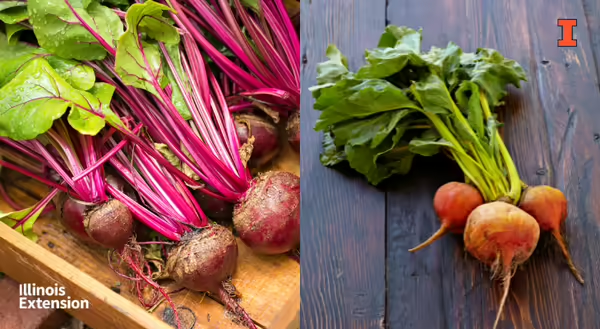
How foods are prepared and the part of the food you eat makes a difference in enjoyment. Beets are an excellent example, since we can eat from root to stalk. For me, cooked beets are not a go-to food. (Except the Chocolate Beet Snack Cake in this post.)
What I like from beets are the beet greens and dehydrated beet "chips." The greens are mild and add variety to salads. And the dehydrated chips are crunchy and less "earthy" tasting than cooked beets.
Nutritionally, 1 cup of diced, cooked beets, also called beetroot, contains around 70 calories, 15g carbohydrates, 3g fiber, and 2g protein. Beets are a source of vitamins and minerals, including several B-vitamins, potassium, and magnesium. Beets do not have a significant amount of fat but do naturally contain some sodium. The leaves and stems of beets are edible and are a source of vitamins and minerals including vitamins A and K, calcium, and potassium.
Buy
Find beetroot in several forms: fresh, canned, dried, and juiced.
- Fresh: Choose small- to medium-sized beets with firm roots and crisp leaves and stems. The roots should not have obvious damage, such as cracks.
- Canned: Like other canned vegetables, canned beets often have salt added. Drain the canning liquid to lower the sodium, or choose no-salt-added or reduced sodium canned beets, if available.
- Dried: Beets are sold dried as sliced dehydrated chips. Choose chips without added salt, if available. Beetroot is also sold as a dehydrated powder, which can be added to smoothies, baked goods, and other recipes for a pop of red/pink color.
- Juiced: Beets are sold juiced, either as just beetroot juice or as a blend with other juices. Pick 100% juices, rather than juices with added sugars.
Price
The cost of beetroot will vary by store and type. Canned beets average $0.73 per cup, according to U.S. Department of Agriculture.
Store
Fresh:
- Cut off beet leaves and stems at the root, leaving around 1-inch of stem attached to the root. According to Home Vegetable Gardening from University of Illinois Extension: “…greens will quickly draw the moisture from the root greatly reducing flavor and the beets will become shriveled.”
- Refrigerate unwashed roots in loosely wrapped food-safe plastic bags or in a food-safe container with a lid. Store the greens with the stems in a bit of water, like a vase of flowers, and cover with a food-safe plastic bag or silicone bag. Store in the refrigerator and change the water every few days.
Canned: Store unopened canned beets in a cool, dry location. Once opened, move leftover beets to a food-safe container and refrigerate for up to 7 days.
Prepare
Rinse the roots, leaves, and stems of fresh beets under water before preparing to remove any soil still present.
Preserve
Try your hand at canning, pickling, or freezing beets at home with directions from the National Center of Home Food Preservation.
Eat
- Beetroot: Cook beets by roasting, boiling, microwaving, and steaming. Mix with herbs, spices, and oil. Or puree cooked beetroot and add to smoothies, pancakes, and hot breakfast cereal, like oatmeal.
- Greens: Mix beet leaves and stems with mild lettuces, if the flavor of the greens is too strong. Or cook beet greens, just like spinach, for a green vegetable side dish. Even try beet greens in place of basil in your favorite pesto recipe.
Stool and Urine Color
Eating beets may cause stool to look dark red and urine to turn red or pink. While any discoloration is surprising, know it is temporary.
Show us how you're enjoying beets lately! Take a picture and tag Illinois Extension on Facebook, Instagram, or Twitter.
Post originally published in 2020; content updated in 2024.
About the Author: Caitlin Mellendorf is an Illinois Extension Nutrition and Wellness Educator serving DeWitt, Macon and Piatt Counties in Central Illinois. She is a Registered Dietitian and her work focuses on helping community members gain the knowledge, skills and tools to live healthier, more nutritious lifestyles. This includes providing programs and answering questions about heart health, diabetes, food safety, food preservation, grocery shopping and cooking. You can reach Caitlin by email at chuth2@illinois.edu or call 217.877.6042.

